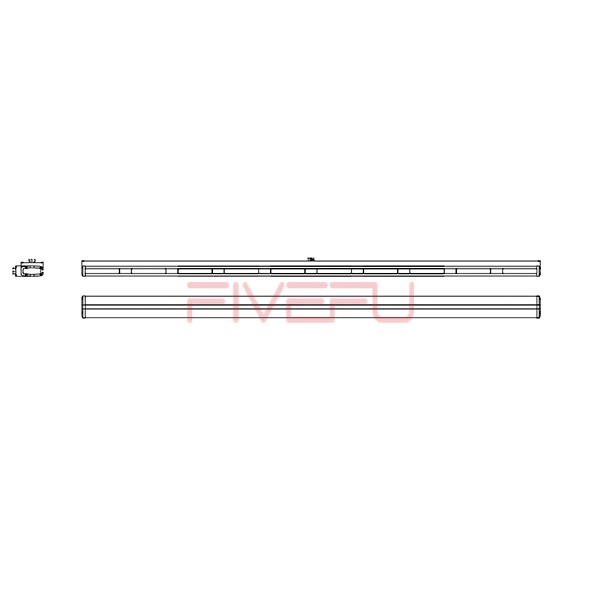Finding the right LED light bar for your vehicle can be a challenge. Poor visibility at night or in rough terrain can affect your driving safety, but the wrong light bar won’t solve the problem. Let’s explore how to choose the best option for your needs.
Choosing the right LED light bar for your vehicle enhances visibility and ensures safety while driving in challenging environments. Let’s explore the key factors to consider when selecting one.
Keep reading to learn how to pick the perfect LED light bar for your vehicle’s needs.
About LED Lights
LED lights, or Light Emitting Diodes, are a modern, energy-efficient lighting technology used in a variety of applications, including automotive lighting. They offer several advantages over traditional lighting, such as halogen or incandescent bulbs. LEDs are known for their long lifespan, energy efficiency, and bright output. In vehicles, LED light bars provide powerful illumination for off-road adventures, emergency vehicles, and enhancing visibility for night driving.
The key benefits of LED lights include:
- Longevity: LEDs can last up to 50,000 hours or more, compared to traditional halogen bulbs that typically last only 1,000 hours.
- Energy Efficiency: They consume less power while providing the same or brighter output, making them ideal for vehicles with limited electrical resources.
- Durability: LEDs are resistant to shocks, vibrations, and extreme temperatures, making them perfect for rugged environments like off-roading or harsh weather conditions.
LED lights have become the go-to choice for modern vehicles due to their superior performance and reliability.
Types of LED Light Bars
LED light bars come in different styles and configurations to meet various lighting needs. The main types include:
- Straight LED Light Bars: These are the most common and versatile, providing a wide beam of light. They are ideal for general driving, off-road use, and emergency vehicles. Straight light bars are available in various lengths, and their design allows for maximum light distribution.
- Curved LED Light Bars: These light bars are designed with a curved shape to follow the contour of your vehicle. This design offers a wider, more focused beam of light, enhancing visibility on both sides of the vehicle. Curved light bars are often preferred for off-road enthusiasts, as they provide better light coverage over uneven terrain.
- Dual Row LED Light Bars: Dual-row light bars feature two rows of LEDs stacked on top of each other, offering double the brightness of single-row bars. They are excellent for those who need intense, long-distance illumination, especially for driving at high speeds in dark environments.
- Flood LED Light Bars: These light bars produce a wide, dispersed beam of light, perfect for illuminating a large area. They are commonly used for off-road driving, construction sites, or working in low-light conditions.
- Spot LED Light Bars: Spot light bars concentrate the light into a narrower beam, allowing you to see further distances. They are ideal for long-distance visibility, like when driving on highways or when you need to spot hazards far ahead.
Choosing the right type depends on your specific needs—whether you need broad coverage or long-distance visibility.
Key Features and Considerations
When selecting an LED light bar, there are several key features to consider:
- Size and Mounting Options: Light bars come in various sizes, from small compact units to larger, more powerful ones. Choose a size that fits your vehicle’s mounting space and meets your brightness needs. Consider the mounting hardware—some light bars come with adjustable brackets for flexible positioning.
- Beam Angle: The beam angle determines how wide or focused the light is. A flood beam provides a broad spread of light, ideal for illuminating areas close to your vehicle. A spot beam, on the other hand, provides long-range visibility. Some light bars offer a combination of both beams for optimal coverage.
- Power and Wattage: The power output of an LED light bar is measured in watts, and higher wattage means brighter light. Ensure your vehicle’s electrical system can handle the power draw of the light bar you choose.
- Waterproof and Dustproof Rating: Look for an IP (Ingress Protection) rating to determine how well the light bar will resist water, dust, and dirt. An IP67 rating means the light bar is fully sealed and can withstand submersion in water up to 1 meter.
- Beam Pattern: Depending on your needs, you may prefer a light bar with a flood pattern for general use or a spot pattern for long-distance illumination. Some models even offer a combination of both patterns for versatile lighting.
- Warranty: A good warranty provides peace of mind. Choose a light bar from a reputable brand that offers a solid warranty to cover potential issues.
Brightness Where You Need It
Brightness is a crucial factor in selecting an LED light bar, but it’s not just about sheer wattage. The light output should match your driving environment. For off-roading, you’ll need high-intensity beams for long-range visibility, especially in remote, dark areas. A light bar with a mix of flood and spot beams will give you the best of both worlds—wide illumination for nearby obstacles and a focused beam for spotting distant hazards.
Consider the lux rating, which measures the intensity of light at a certain distance. The higher the lux rating, the more powerful the light. A light bar with high lux output is ideal for off-road, nighttime driving, as it provides superior visibility in challenging conditions.
Positioning is also important: mounting the light bar at the right height and angle can ensure the light reaches the road ahead and illuminates obstacles in your path without blinding other drivers.
Conclusion
Choosing the right LED light bar is essential for enhancing your vehicle’s visibility and ensuring safety in various driving conditions. Consider factors like type, features, and brightness to find the best fit for your needs.









